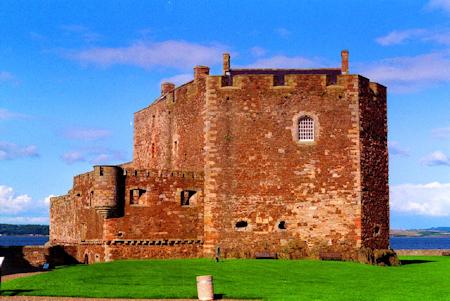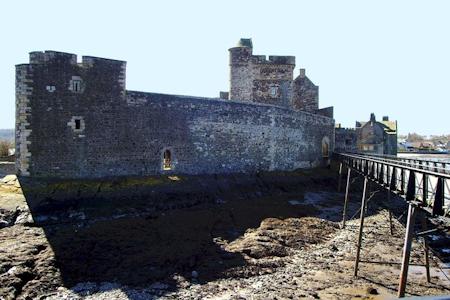
Blackness Castle
Blackness Castle is situated on the southern shore of the Firth of Forth near Edinburgh. Over the years it has served as a royal fortress, state prison and ammunition depot. The Army gave it up after the First World War and it is now in the care of Historic Scotland.
Blackness was built in the 1440s by Sir George Crichton, Lord High Admiral of Scotland. His seafaring connection might explain why the castle looks like a battleship moored to the rocks. Indeed, it is referred to locally as 'the ship that never sailed'.
A State Prison
The castle originally consisted of the North Tower and an enclosing wall. It is protected by water on three sides and by a rock-cut ditch on the south (landward) side. The south side also possibly held a hall for the castle however it was replaced by the South Tower in the 16th Century.
Sir George didn't keep his castle for very long. By 1449 it was in use as a state prison and Sir George gifted it to James II in 1453. It was probably a wise move as Scotland was almost in a state of civil war in the early 1450s.
Blackness was far enough from Edinburgh that it could serve as a handy prison for political prisoners and enemies of the Stewart kings.
High status prisoners would have been kept in the tower. If you were unfortunate enough to be of low rank then you would have been kept in the pit prison. Twice a day the bitterly cold waters of the Forth flooded the pit through a grate in the wall soaking the prisoners.
Defending the Firth
In the spring and autumn of 1481 an English raiding party under Sir Robert Radcliffe harassed shipping in the Forth and badly burned Blackness Castle as part of their campaign.
Despite this Blackness was still a powerful fortification.
In 1534 Sir James Hamilton of Finnart was employed to upgrade the defences. He was an accomplished architect and military engineer. His own home at Craignethan Castle had become a showcase for his revolutionary ideas.
At Blackness the walls were considerably strengthened and the Central Tower was constructed. Gun ports were added to the walls and the gate was strengthened with a caponier.
The caponier was a very unusual feature – a covered gun tunnel allowing the defenders to fire at anyone breaching the gate – and one of only three left in Scotland. The other two are at Stirling and Craignethan.
After the forced abdication of Mary, Queen of Scots Blackness changed hands a few times in the civil war that followed.
In 1650 Blackness was besieged by the Parliamentarians under General Monck. It was bombarded from both the land and sea and Blackness fell despite its extensive fortifications.
The castle was repaired in the late 1660s. It was in use as a prison holding Covenanters. The North Tower was reduced in height and had guns added to its roof.
In 1870 Blackness became an important ammunition depot. The courtyard was roofed over and a barracks was added.
The depot was finally closed after the First World War. Between 1926 and 1935 a major restoration project was undertaken and most of the 19th Century work was removed and the castle was restored back to an almost medieval state.
Today the castle is looked after by Historic Scotland who open it to the public as an Historic Monument. Facilities available at Blackness include toilets, a gift shop and tea and coffee. There are display boards around the castle explaining its various features and history and a guide book and children's quiz are available.
The castle has been used as a location for a number of films including Franco Zeffirelli's "Hamlet", BBC Television's "Ivanhoe" and the 2008 film "Doomsday".
Status: Visitor Attraction / Heritage Site
Owner: Historic Scotland
Tel: +44 (0)1506 834 807
Website: www.historic-scotland.gov.uk
Opening Times: 1st April to 30th September Daily 9.30am-5.30pm / 1st October to 31st March Sat-Wed 9.30am-4.30pm


Blackness Castle looking over the Forth

Blackness Castle looking ship-like from the side